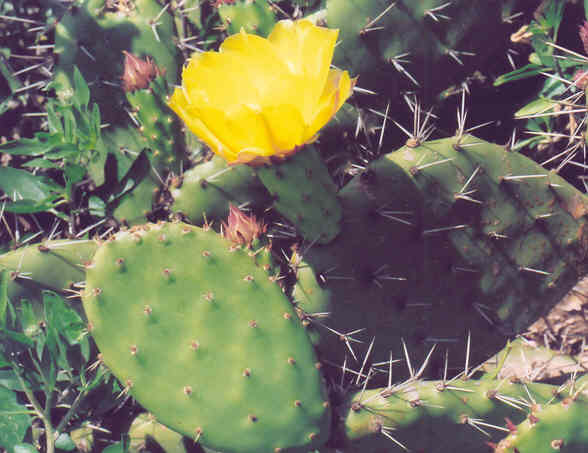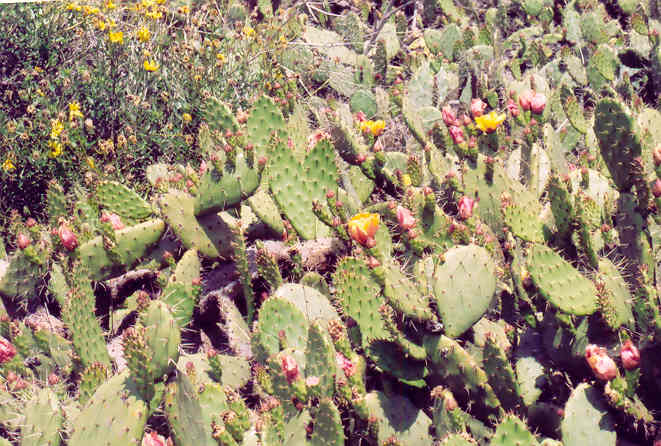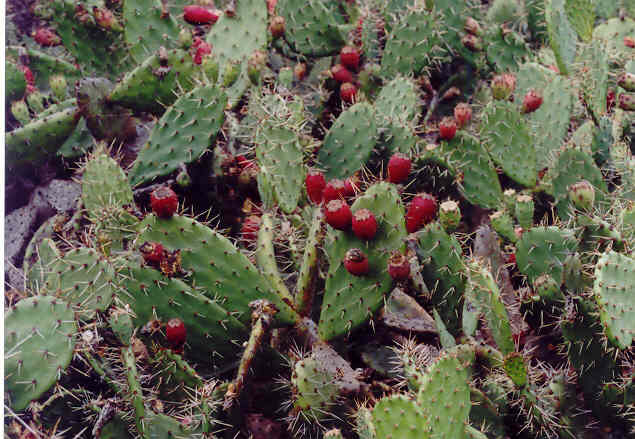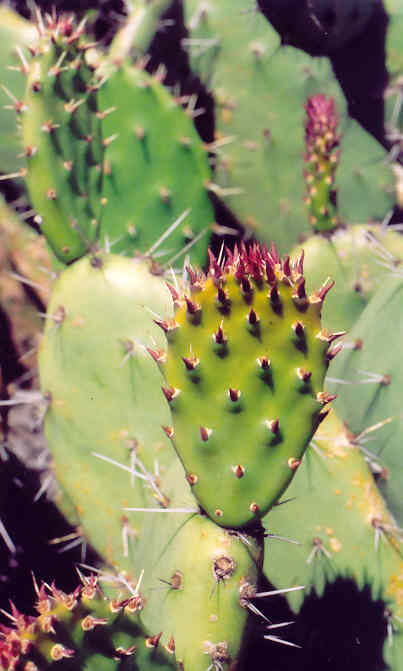
Cactus Family
Origin unknown
Opuntia
 |
Cactus Family Origin unknown
Opuntia
|
Plant Characteristics: Stems sprawling to erect, about .8 m. high and of greater diameter, without a trunk; joints green, narrowly elliptic or narrowly obovate, 11-15 cm. wide, most in the 11 cm. range, +/- 25 cm. long, +/- 38-45 areoles per joint, the lower 8-10 without spines; spines white, mostly 3 per areole, dark tipped, the longest 1.5-2 cm. long, others shorter; new leaves awl shaped, 5-6 mm. long; fls yellow, style pink, stigma green, filaments yellow; fr. 5 cm. long, fleshy, reddish purple, oblanceolate in shape with a flat top, areoles few, most with fine hairs, some with short spines.
Habitat: As with other Opuntias the range could be quite large, however, if it is assumed that one of the parents of this hybrid is Opuntia littoralis, then the range would be limited to Coastal Sage Scrub, low elevations and inland 15-40 miles. (my comments).
Name: Opuntia, an old Latin name used by Pliny, formerly belonging to some other plant. (Munz, Flora So. Calif. 914).
General: Found in only one location to date, however, there may be more along the bluffs surrounding the upper bay. This colony is found on the bluff, southerly of the Interpretive Center and adjacent to the place where the bluff becomes vertical at the end of the Delhi channel. Differs from Opuntia littoralis by having a narrower pad width, fewer areoles, with fewer and shorter spines per areole. Some areoles are with no spines. Spine color is consistently white, while with O. littoralis there is a mixture of white, gray and yellow spines. The fruits are longer and more tapered at the bottom than with O. littoralis. (my comments). My old mentor John Johnson has the following comments about the origin of hybrids in the area: “I suspect it is a variation of Opuntia littoralis. One can say it is a hybrid, but what other species are local with which its parent could hybridize? Very possibly it may be that all of the local cacti are hybrids, and as they cross-fertilize, random and independent assortment take place involving many different sets of genetic traits that result in an enormous variety among the offspring. This idea appeals to me as the best explanation for the many variations that one observes among the wild-growing cacti.” (John Johnson) Probably 300 species from the Straits of Magellan to s. Canada. (Munz, Flora So. Calif. 314). Dawson states that the more we learn about cactus, the less certain we are of just how many species there are. (Dawson 6).
Text Ref: Dawson 15; Hickman Ed. 452; Munz, Flora So. Calif. 314.
Photo Ref: Mar. 03 # 3,4,5,6,7; Oct. 03 #17,18.
Identity: by R. De Ruff
First Found: March 2003.
Computer Ref: Plant Data 557.
No plant specimen.
Last edit. 8/13/05.
 |
 |
 |